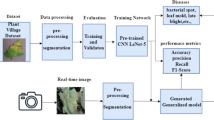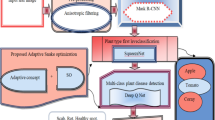Abstract
Tomatoes are widely cultivated and consumed worldwide and are susceptible to various leaf diseases during their growth. Therefore, early detection and prediction of leaf diseases in tomato crops are crucial. Farmers can take proactive measures to prevent the spread and minimize the impact on crop yield and quality by identifying leaf diseases in their early stages. Several Machine Learning (ML) and Deep Learning (DL) frameworks have been developed recently to identify leaf diseases. This research presents an efficient deep-learning approach based on a hybrid classifier by optimizing the CNN and LSTM models, which helps to enhance classification accuracy. Initially, Median Filtering (MF) is used for leaf image pre-processing. Then, an improved watershed approach is used for segmenting the leaf images. Subsequently, enhanced Local Gabor Pattern (LGP) and statistical and color features are extracted. An optimized CNN and LSTM are used for classification, and the weights are tuned using the SISS-OB (Self Improved Shark Smell With Opposition Behavior) algorithm. Finally, we have analyzed the performance using various measures. Since we have done segmentation, feature extraction, and optimization improvisations, our proposed methodology results are higher than other available methods and existing works. The results obtained at Learning Percentage (LP) is 90% which is far superior to those obtained at other LPs. The FNR (False Negative Rate) is much lower (0.05) at the 90th LP. The proposed model achieved better classification performance in terms of Accuracy of 97.13%, Sensitivity of 95.09%, Specificity of 95.24%, Precision of 94.31%, F measure of 96.71% and MCC 87.34%.












Similar content being viewed by others
Data Availability
The data that support the findings of this study are openly available in the public domain [kaggle Tomato leaf disease detection] https://www.kaggle.com/kaustubhb999/Tomatoleaf [8]. We have provided the link to the dataset and the code to access it. We have given Google Drive link to access code https://drive.google.com/drive/folders/155H1Q9-9D77fu-pEWb2ncStDeUPIPTPg?usp=share_link. We will provide the code access publicly through our GitHub repository once the article is published.
Abbreviations
- AOA:
-
Arithmetic Optimization Algorithm
- AROA:
-
Archimedes Optimization Algorithm
- BES:
-
Bald Eagle Search
- BI-GRU:
-
Bidirectional Gated Recurrent Unit
- CNN:
-
Convolutional Neural Network
- DNN:
-
Deep Neural Network
- DT:
-
Decision Tree
- DL:
-
Deep Learning
- DBN:
-
Deep Belief Network
- ICRMBO:
-
Improved Crossover-Based Monarch Butterfly Optimization
- FPR:
-
False Positive Rate
- FNR:
-
False Negative Rate
- GAN:
-
Generative Adversarial Network
- HC:
-
Hybrid classifiers
- LGP:
-
Local Gabor Pattern
- LBP:
-
Local Binary Pattern
- LP:
-
Learning Percentage
- LDF:
-
Local Distribution Feature
- MCC:
-
Matthews Correlation Coefficient
- MF:
-
Median Filtering
- ML:
-
Machine Learning
- MLP:
-
Multilayer Perceptron Neural Network
- NPV:
-
Negative Predictive Value
- RF:
-
Random Forest
- PCA:
-
Principal Component Analysis
- PRI:
-
Photochemical Reflectance Index
- ResNet101:
-
Residual Network101
- WOA:
-
Whale Optimization Approach
- SVM:
-
Support Vector Machine
- SGD:
-
Stochastic Gradient Descent
- SSA:
-
Salp Swarm Algorithm
- SISS-OB:
-
Self Improved Shark Smell With Opposition Behavior
- STDA:
-
Stepwise Discriminant Analysis
- SSO Shark:
-
Smell Optimization
- TL-DCNN:
-
Transfer Learning-Based Deep CNN
- TL:
-
Transfer Learning
- VIs:
-
Vegetation Indices
- VAEs:
-
Variational Auto Encoders
- WT:
-
Watershed Transform
References
Patil MA, Manohar M. Enhanced radial basis function neural network for tomato plant disease leaf image segmentation. Ecol Inform. 2022;70: 101752.
Pal M, Edwards MG. Archives of computational methods in engineering: numerical convergence and the maximum principle. Arch Comput Methods Eng State of the Art Rev. 2010;17(2):137–89.
Healthline: Tomatoes 101: nutrition facts and health benefits. 2023. https://www.healthline.com/nutrition/foods/tomatoes. Accessed 3 Feb 2023.
Zhou C, Zhou S, Xing J, Song J. Tomato leaf disease identification by restructured deep residual dense network. IEEE Access. 2021;9:28822–31.
Yang G, Chen G, He Y, Yan Z, Guo Y, Ding J. Self-supervised collaborative multi-network for fine-grained visual categorization of tomato diseases. IEEE Access. 2020;8:211912–23.
Zhang Y, Song C, Zhang D. Deep learning-based object detection improvement for tomato disease. IEEE Access. 2020;8:56607–14.
Vikaspedia: Tomato: diseases and symptoms. 2020. https://vikaspedia.in/agriculture/crop-production/integrated-pest-managment/ipm-for-vegetables/ipm-strategies-for-tomato/tomato-diseases-and-symptoms#:~:text=Early%20blight,-Damage%20symptoms&text=This%20is%20a%20common%20disease,mostly%20on%20the%20older%20foliage.. Accessed 24 Nov 2020.
Kaggle Tomato Dataset. 2022. https://www.kaggle.com/datasets/kaustubhb999/tomatoleaf. Accessed 1 Nov 2022.
Gonzalez-Huitron V, León-Borges JA, Rodriguez-Mata A, Amabilis-Sosa LE, Ramírez-Pereda B, Rodriguez H. Disease detection in tomato leaves via cnn with lightweight architectures implemented in raspberry pi 4. Comput Electron Agric. 2021;181: 105951.
Abbas A, Jain S, Gour M, Vankudothu S. Tomato plant disease detection using transfer learning with c-gan synthetic images. Comput Electron Agric. 2021;187: 106279.
Mkonyi L, Rubanga D, Richard M, Zekeya N, Sawahiko S, Maiseli B, Machuve D. Early identification of Tuta absoluta in tomato plants using deep learning. Sci Afr. 2020;10:00590.
Wspanialy P, Moussa M. A detection and severity estimation system for generic diseases of tomato greenhouse plants. Comput Electron Agric. 2020;178: 105701.
Liu J, Wang X. Early recognition of tomato gray leaf spot disease based on mobilenetv2-yolov3 model. Plant Methods. 2020;16:1–16.
Ashwathappa K, Venkataravanappa V, Nandan M, Hiremath S, Reddy CL, Shankarappa K, Reddy MK. Association of tomato leaf curl Karnataka virus and satellites with enation leaf curl disease of Pseuderanthemum reticulatum (radlk.) a new ornamental host for begomovirus infecting tomato in india. Indian Phytopathol. 2021;74:1065–73.
Prasad A, Hari-Gowthem G, Muthamilarasan M, Hussain Z, Yadav PK, Tripathi S, Prasad M. Molecular characterization of slatg18f in response to tomato leaf curl New Delhi virus infection in tomato and development of a caps marker for leaf curl disease tolerance. Theor Appl Genet. 2021;134:1463–74.
Basavaiah J, Arlene Anthony A. Tomato leaf disease classification using multiple feature extraction techniques. Wirel Pers Commun. 2020;115(1):633–51.
Wang H, Sanchez-Molina JA, Li M, Berenguel M. Development of an empirical tomato crop disease model: a case study on gray leaf spot. Eur J Plant Pathol. 2020;156:477–90.
Mohammed HS, El Siddig MA, El Hussein AA, Navas-Castillo J, Fiallo-Olivé E. Complete genome sequence of Datura leaf curl virus, a novel begomovirus infecting Datura innoxia in Sudan, related to begomoviruses causing tomato yellow leaf curl disease. Adv Virol. 2018;163(1):273–5.
Lee H-J, Kim N-K, Hwang S-Y, Yang K-Y, Jeong R-D. First report of tomato spotted wilt virus infecting parlor palm (Chamaedorea elegans) with leaf mosaic and ring spot disease in Korea. J Plant Pathol. 2021;104:1.
Kumari S, Krishnan N, Dubey V, Pandey KK, Singh J. Characterization of recombinant tomato leaf curl Palampur virus causing leaf curl disease of Basella alba l. in India. J Plant Pathol. 2020;102:523–7.
Varun P, Saxena S. Association of tomato leaf curl Gujarat virus and tomato leaf curl Bangladesh betasatellite on papaya showing typical leaf curl symptoms in north india. 3 Biotech. 2018;8(5):243.
Venkataravanappa V, Ashwathappa K, Reddy CL, Shankarappa K, Reddy MK. Characterization of tomato leaf curl New Delhi virus associated with leaf curl and yellowing disease of watermelon and development of lamp assay for its detection. 3 Biotech. 2020;10:1–12.
Patil MA, Manohar M. A comprehensive review on crop disease prediction based on machine learning and deep learning techniques. In: Congress on Intelligent Systems. Springer. 2022; pp. 481–503.
Nandhini S, Ashokkumar K. Improved crossover based monarch butterfly optimization for tomato leaf disease classification using convolutional neural network. Multimed Tools Appl. 2021;80:18583–610.
Thangaraj R, Anandamurugan S, Kaliappan VK. Automated tomato leaf disease classification using transfer learning-based deep convolution neural network. J Plant Dis Prot. 2021;128(1):73–86.
Ahmed N, Zaidi SS-e-A, Amin I, Scheffler BE, Mansoor S. Tomato leaf curl Oman virus and associated betasatellite causing leaf curl disease in tomato in Pakistan. Eur J Plant Pathol. 2021;160:249–57.
Gadekallu TR, Rajput DS, Reddy MPK, Lakshmanna K, Bhattacharya S, Singh S, Jolfaei A, Alazab M. A novel pca-whale optimization-based deep neural network model for classification of tomato plant diseases using gpu. J Real-Time Image Proc. 2021;18:1383–96.
Abdulridha J, Ampatzidis Y, Kakarla SC, Roberts P. Detection of target spot and bacterial spot diseases in tomato using uav-based and benchtop-based hyperspectral imaging techniques. Precis Agric. 2020;21:955–78.
Wang X, Liu J, Zhu X. Early real-time detection algorithm of tomato diseases and pests in the natural environment. Plant Methods. 2021;17(1):1–17.
Prabhakar M, Purushothaman R, Awasthi DP. Deep learning based assessment of disease severity for early blight in tomato crop. Multimed Tools Appl. 2020;79:28773–84.
Patil MA, Adamuthe AC, Umbarkar AJ. Smartphone and iot based system for integrated farm monitoring. In: Techno-Societal 2018: Proceedings of the 2nd International Conference on advanced technologies for societal applications-Volume 1. Springer. 2020; pp. 471–478.
Zhu Y, Huang C. An improved median filtering algorithm for image noise reduction. Phys Proc. 2012;25:609–16.
Sivakumar V, Janakiraman N. A novel method for segmenting brain tumor using modified watershed algorithm in mri image with fpga. Biosystems. 2020;198: 104226.
Narwade J, Kumar B. Local and global color histogram feature for color content-based image retrieval system. In: Proceedings of the International Congress on information and communication technology: ICICT 2015, Volume 1. Springer. 2016; pp. 293–300.
Patil MA, Manur M. Sensitive crop leaf disease prediction based on computer vision techniques with handcrafted features. Int J Syst Assur Eng Manag. 2023. https://doi.org/10.1007/s13198-023-02066-0.
Zhou X, Lin J, Zhang Z, Shao Z, Chen S, Liu H. Improved itracker combined with bidirectional long short-term memory for 3d gaze estimation using appearance cues. Neurocomputing. 2020;390:217–25.
Gu J, Wang Z, Kuen J, Ma L, Shahroudy A, Shuai B, Liu T, Wang X, Wang G, Cai J, et al. Recent advances in convolutional neural networks. Pattern Recogn. 2018;77:354–77.
Mohammad-Azari S, Bozorg-Haddad O, Chu X. Shark smell optimization (sso) algorithm. In: Advanced optimization by nature-inspired algorithms. 2018; pp. 93–103.
Rajakumar BR. Impact of static and adaptive mutation techniques on the performance of genetic algorithm. Int. J. Hybrid Intell. Syst. 2013;10(1):11–22.
Rajakumar B. Static and adaptive mutation techniques for genetic algorithm: a systematic comparative analysis. Int J Comput Sci Eng. 2013;8(2):180–93.
Sujatha R, Chatterjee JM, Jhanjhi N, Brohi SN. Performance of deep learning vs machine learning in plant leaf disease detection. Microprocess Microsyst. 2021;80: 103615.
Acknowledgements
The Department of CSE, School of Engineering and Technology, Christ(Deemed to be University), Kengeri Campus, Bengaluru, India, and the Department of CSE, G. Narayanamma Institute of Technology and Science, Shaikpet, Hyderabad, Telangana, India, supports this work includes non-financial support.
Author information
Authors and Affiliations
Corresponding author
Ethics declarations
Conflict of interest
The authors declare that they have no known competing financial interests or personal relationships that could have appeared to influence the work reported in this paper.
Additional information
Publisher's Note
Springer Nature remains neutral with regard to jurisdictional claims in published maps and institutional affiliations.
Rights and permissions
Springer Nature or its licensor (e.g. a society or other partner) holds exclusive rights to this article under a publishing agreement with the author(s) or other rightsholder(s); author self-archiving of the accepted manuscript version of this article is solely governed by the terms of such publishing agreement and applicable law.
About this article
Cite this article
Patil, M.A., Manohar, M. Plant Leaf Disease Classification Using Optimal Tuned Hybrid LSTM-CNN Model. SN COMPUT. SCI. 4, 710 (2023). https://doi.org/10.1007/s42979-023-02245-7
Received:
Accepted:
Published:
DOI: https://doi.org/10.1007/s42979-023-02245-7




